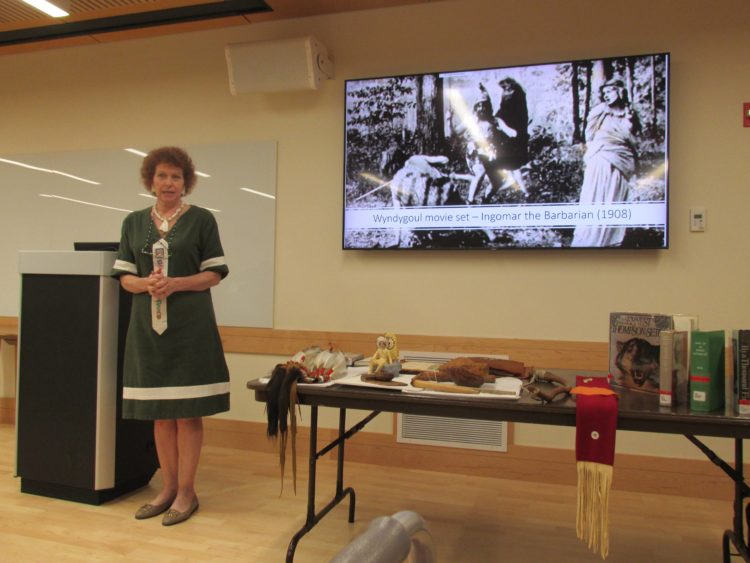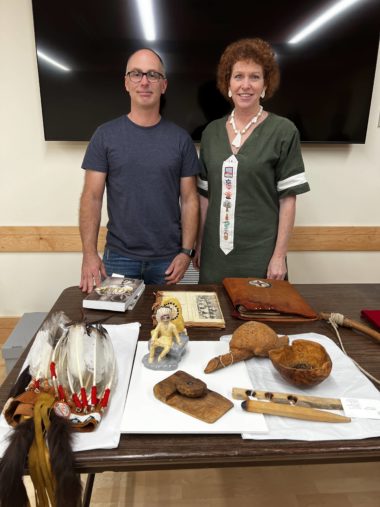Ernest Thompson Seton – a good summer read attests his granddaughter Julie Seton

By Anne W. Semmes
On Saturday last one of Greenwich’s most famous residents of yesteryear, Ernest Thompson Seton, was brought captivatingly alive by his visiting granddaughter, Julie Seton. In her talk at the Greenwich Library, she kicked off the library’s annual Adult Summer Reading program, with its theme of Read Beyond the Beaten Path. And surely there are no shortages of Ernest Thompson Seton books at the ready for reading.
“Ernest Thompson Seton’s youngest granddaughter, Julie A. Seton, is carrying his legacy forward through her personal research and through the Ernest Thompson Seton Institute,” introduced Librarian Siobhan Schugmann in the Library’s Black Box Theater. “Her serious research on him began in the mid-1990s and she travels worldwide to meet people influenced by Seton, including Sir David Attenborough, and Scouts and Woodcrafters in Czechia, Poland, and Canada to spread the word on how Seton’s work influences our world today.”
Yes, Seton’s book, “Wild Animals I Have Known,” reportedly gave his friend Rudyard Kipling the idea for his Jungle Books. Kipling in turn urged Seton to write his still-in-use Woodcraft manuals on campcraft and nature study. One of those manuals will be instructing this summer in Poland, told Julie Seton.
But it’s the fascinating life of Grandfather Seton as lived before and during his 30 years in Greenwich from 1900 to 1930, that was captivating to the audience. As a youth exploring the woods in near Toronto, Julie described Seton as hungry to learn everything about birds. He was known to count every feather of a grackle, equaling near 5,000 feathers. “He collected also thousands of animals to ‘know’ them, to study them inside and out in the name of science.” And many of those specimens are still held at the Smithsonian Institute and at New York’s American Museum of Natural History.
“He wrote in his journal nearly every day for 65 years with details about the animals he observed, the weather, and the measurements he took,” Julie noted. Grandfather Seton was also a noted artist having secured a scholarship at the Royal Academy of Art, then studying art in Paris. So those journals, stored away at the American Museum of Natural History, are full of lively drawings and writings as personally seen by this reporter.
It was at the age of 17, that Julie, living in New Mexico where her grandfather moved to from Greenwich, was gifted a trip to New York to investigate her grandfather in the archives of the New York Public Library. What she found in his drawings and correspondence would set her on a path of discovery. Her PhD dissertation told of the impact of Seton’s tales of the wolf Lobo on nature writing. She was intrigued by the story of Seton being drawn to a mystic who told him “He was a native in white skin, and it was his job to tell the Native American stories as at that time natives were not allowed to tell the stories themselves… They were forbidden and put in jail for doing those dances, for talking in their languages.”
“So, ‘The Gospel of the Redman’ was one of the books compiled by my grandparents and republished by my mother before her death [with a most informative introduction},” shared Julie. “It consolidates the (native) values, describing life cycle etiquettes and also captures Seton’s Woodcraft program.” It was that section on how that indigenous culture prepares for death with a Death Song that spoke reams to Julie upon the death of her brother, Dan. “He called to say it was the last time we could talk,” she told. She believed she heard his death song.

It was in Cos Cob at Seton’s “Wyndygoul” estate that Seton would make that Woodcraft program come alive, by inviting young schoolkids from the neighborhood to participate in some of those native American rituals. “He bought six farms, for as little as $10 an acre,” Julie told, “and transformed then into the now known Pomerance Park…He built it to be a nature preserve.”
But first he had to overcome the vandalism by local kids feeling Seton had stolen their wilderness playground. Seton had the answer. One day in May he went to the local school, “and he invited all the boys 12-years-old and up for a weekend Indian-style campout…Bring two blankets, a change of clothes, but no alcohol. No guns. No tobacco.” Over a dozen showed up. “The vandalizing renegades and their accomplices became friends of Seton’s for life.”
“Within a year 40 bands of Woodcraft Indians had been formed,” shared Julie. “They adopted the motto, ‘The best things of the best Indians.’” There were three categories of activity: athletics, campcraft and nature study. “They learned how to light a fire without matches, using a fire board, bow and spindle.” And there on a table before us were displayed those items brought from the Bruce Museum’s archives by Collection Manager Tim Walsh. Also displayed a War-Bonnet/Headdress of feathers. “Each feather represents a task completed,” said Walsh as “analogous to the first merit badges of the Boy Scouts.”
Indeed, some of those Woodcraft Indians at Wyndygoul would emerge as Boy Scouts, with the establishing of the Scouts in 1908, with the Boy Scouts of America in 1910 with Seton named as Chief Scout and Theodore Roosevelt as Honorary President. Seton would compile the “Boy Scouts of America: A Handbook of Woodcraft, Scouting, and Life-craft using his Birch Bark Roll.”
But big changes occurred when Seton sold Wyndygoul in 1912 to Maurice Wertheim, father of Barbara Tuchman, and moved his nature preserve and Woodcraft/Boy Scout activities to Lake Avenue where he lived with wife Grace Gallatin Seton and their daughter Anya Seton, of later literary fame. Working for the Setons were Seton’s personal assistant Julia Buttree, with her husband Ted serving as property manager. With the Seton marriage breaking up and the move to New Mexico in 1929 would bring Seton’s marriage to Julia Moss Buttree in 1935. Their adopted daughter named Beulah after Seton’s favorite poem “Beulah Land” became the mother of Julie Seton.
Julie Seton would follow her talk at Greenwich Library with a two-day retreat at Camp Seton in Greenwich sponsored by the Ernest Thompson Seton Institute. She then served as keynote speaker at the Camp at its Eagle Scout Recognition Dinner. She describes the mission of the Ernest Thompson Seton Institute as “Through expansive thinking and acting, the Institute inspires curiosity and respect for nature and humanity aligned with ET Seton’s ideals.” Membership is $30 for adults and free for 18 and under. For more information visit etsetoninstitute.org





